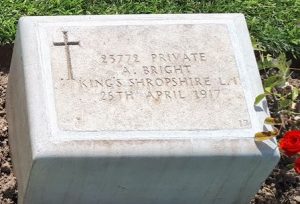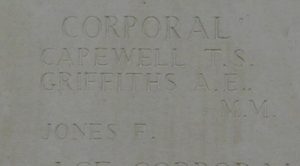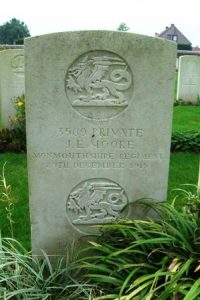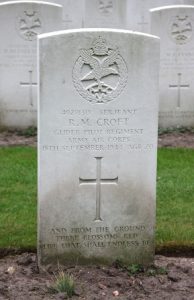Evenjobb is a small village situated about five miles west-south-west of Presteigne and six miles north-west of Kington, in the old county of Radnorshire. Within the village is the Parish Church of St. Peter’s. The men of the Parish who fell during the Great War are commemorated on a Celtic cross styled war memorial, which is located inside the Churchyard, while inside the Church is a memorial to the three Croft brothers who fell during World War Two.
The Great War, 1914-1918
Andrew Bright, Private, 23772, King’s Shropshire Light Infantry. Andrew was the son of George and Alathea Bright, of Sunnybank, Evenjobb. By 1911 he was living at Bedwellty where he worked as a railway platelayer. He enlisted at Glasbury into the King’s Shropshire Light Infantry and in 1916 was posted to Salonika, joining the 8th Battalion, King’s Shropshire Light Infantry, which was attached to 66 Brigade, 22nd Division. The Division had moved to Salonika from France in November 1915, and took part in the Retreat from Serbia during December 1915, following the defeat of the Serbian army by the Bulgarians. Between 10 to 18 August 1916 the Division fought at the battle of Horseshoe Hill, then between 13 to 14 September 1916 at the battle of Machukovo. Andrew was killed in action during the Battle of Doiran, on 25 April 1917, aged 33. He is buried in Doiran Military Cemetery, Greece.

Albert Edward Griffiths, MM, Corporal, 26801, South Wales Borderers. Albert was the son of Edward and Martha Griffiths, of Brook House, Evenjobb. He worked as a slaughterman at Ludlow prior to the war. Albert enlisted at Brynmawr into the South Wales Borderers and was posted to France in 1916, joining the 2nd Battalion, South Wales Borderers, which had moved to the Somme sector on 15 March 1916 following service in China and Gallipoli attached to 87 Brigade, 29th Division. The Division took part in its first major action in France during the 1916 Somme Offensive, suffering terrible casualties during its assault on Y-Ravine, Beaumont Hamel on the opening day. It was moved to the Ypres sector to rebuild before returning to the Somme and fought at the Battle of Le Transloy. Albert was awarded the Military Medal for his work at the Somme. In the Spring of 1917, the Division fought at the Battle of the Scarpe, which was part of the Arras Offensive, and then moved further north to Ypres, where it saw heavy fighting again. Later that year the Division was moved back south and took part in the Battle of Cambrai. The 2nd SWB moved from Fins via Gouzeaucourt on 20 November 1917 to positions near Masnières in readiness for an assault on the German lines the following morning. The attack was supported by a squadron of tanks, but met with very heavy resistance and was held up short of its objectives and orders were received to withdraw. Albert had been killed during the assault that day, on 21 November 1917, aged 29. He has no known grave and is commemorated on the Cambrai Memorial, Louverval, France.

Joseph Edward Moore, Private, 3569, Monmouthshire Regiment. Joseph was the son of George and Lizzie Moore of Evenjobb. He worked at Tredegar prior to the war and enlisted at Abergavenny into the 3rd Battalion, Monmouthshire Regiment. The battalion had embarked for France on 14 February 1915 attached to 83 Brigade, 28th Division and saw heavy fighting during the Second Battle of Ypres. Following heavy casualties, the 1st, 2nd and 3rd Battalions of the Monmouthshire Regiment merged to form a composite battalion, but following the arrival of large numbers of reinforcements, the battalions resumed their identities on 11 August 1915. On 2 September 1915 the 3rd Monmouth’s became the Pioneer Battalion to the 49th Division and moved to the Canal Bank sector north of Ypres. On 29 December 1915 the was in camp at Elverdinghe, preparing to move back to No 4 Rest Camp at Poperinghe, when the Germans fired a barrage of shells, which exploded in their midst, causing 69 casualties, 41 of which were instantly killed. Joseph was among the dead. The 22-year-old is buried in what amounts to a mass grave at Ferme Olivier Cemetery, Ieper, Belgium.

World War Two, 1939-1945
Godfrey Stuart Croft, Trooper, 7889720, Royal Armoured Corps. Godfrey was born in 1920, the son of Major Rodolphus Croft, and of Mary Elizabeth Croft (nee Wozencroft), of Belmont House, Presteigne. He enlisted into the 5th Royal Tank Regiment, Royal Armoured Corps following the outbreak of war. The Regiment served with the BEF in France until the survivors were evacuated from Dunkirk in 1940. After the evacuation it was re-equipped and then sailed to the Middle East as part of the 3rd Armoured Brigade, 1st Armoured Division. When Rommel counter-attacked in April 1941 it was part of 3rd Armoured Brigade and along with 3rd Hussars and 6th RTR it fell back on Tobruk. There it formed part of the Tobruk garrison until it embarking on 14 April 1941 for Egypt. After a re-fit it joined 4th Armoured Brigade and took part in the Battleaxe battles of November 1941 and the Gazala battles of May and June 1942, withdrawing with the rest of the 8th Army to El Alamein. Godfrey was killed at Gazala on 29 May 1942, aged 22. He has no known grave and is commemorated on the Alamein Memorial, Egypt. He is also commemorated along with his father and brother on the Presteigne War Memorial.
Rodolphus Croft, Flying Officer, 82776, Royal Air Force. Rodolphus was born at St. Owens, Hertfordshire on 4 September 1881, the son of Arthur and Martha Ellen Croft. He had enlisted into the King’s Shropshire Light Infantry prior to the Great War, giving his home address as Thorne, Presteigne, and married Mary Elizabeth Wozencroft in 1911. By 1914 was serving as Regimental Sergeant Major with the 1st KSLI. He was discharged to a commission in the West African Regiment on 29 August 1915 and by the end of the war had been promoted to Major. He returned to the family home at Presteigne after the war. On 28 June 1940 he was granted a commission as Pilot Officer with the RAF for the duration of the war. Flying Officer Rodolphus Croft relinquished his commission due to ill health on 3 June 1942 and returned home to Presteigne, where he died on 5 April 1944, aged 62. Little else is known of his service, as he is not commemorated as a casualty by the CWGC. He is also commemorated along with his two sons, who fell during WW2, on the Presteigne War Memorial.
Roger Malcolm Croft, Serjeant, 4929130, Army Air Corps. Roger was born in 1923, the son of Major Rodolphus Croft, and of Mary Elizabeth Croft (nee Wozencroft), of Belmont House, Presteigne. He enlisted into the army after the outbreak of war. His original unit is not currently known, but on 5 September 1940 volunteers from No 2 Commando were selected for pilot training and attached to RAF Army Cooperation Squadrons. Combat gliders were still under development, so the pilots trained under the existing RAF elementary flying training regime in powered aircraft before converting to gliders. When the Army Air Corps was formed on 21 December 1940, the Glider Pilot Regiment was included within it. The first deployment for the Regiment came in North Africa, and then at Sicily, during Operation Husky. The Regiment returned to England to prepare for the invasion of Normandy, famously playing an important role in the capture and holding of Pegasus Bridge and the capture of the Merville Battery. Their next major action was at Operation Market Garden, an audacious plan to seize the Rhine crossing at Arnhem. The air element of Operation Market Garden was code-named ‘Market’ and the first lift took off from air bases in England on 09.45 onwards on Sunday 17 September 1944. The gliders were to land in a large open area at Oosterbeek, while the paratroopers of the 1st Airborne Division would also land at Oosterbeek. Roger was the Co-Pilot of Horsa Cn. 883, of B Squadron, in the 1st Wing, carrying men of the 1st Airlanding Light Regiment. There are varying reports of his death at Arnhem. One report was that he was killed when his glider crashed upon landing on the 17th, another that he died of wounds suffered the following day, whilst another theory is that he died on the 19th, as he was originally buried in the garden of the Ter Horst family, Benedendorpsweg, Oosterbeek. Nevertheless, the official date given for his death was 18 September 1944. The 20-year-old is buried in Arnhem Oosterbeek War Cemetery, Netherlands. He is also commemorated along with his father and brother on the Presteigne War Memorial.
